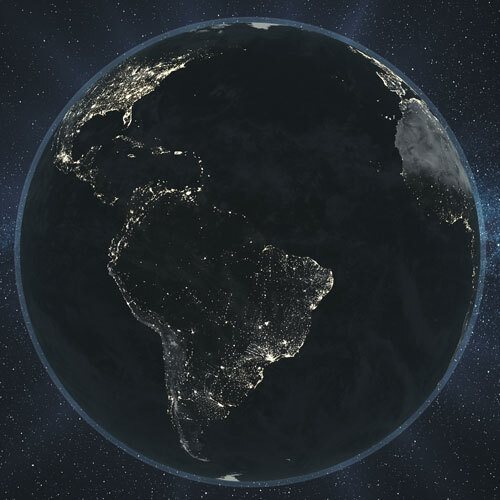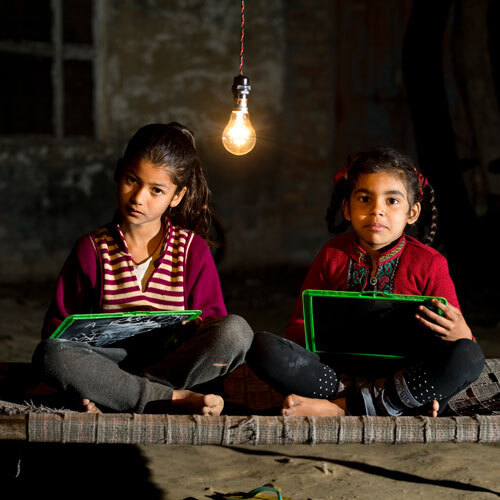Access to Energy: bringing electricity to everyone
Getting home and switching the light on is a simple gesture, a right that we consider as acquired. However, 789 million people live without this right. To extend Access to Energy to all regions, on all continents, by investing in renewable energies, is to bring comfort to families, but also to the planet.
It is practically impossible to imagine modern life without electricity. Just think about what we do and the appliances we use right from when we wake up, think about "giving up" on this exercise. However, according to the UN, there are still about 789 million people living without any access to electricity, about 10% of the world's population. More than the entire population of Europe, and once and a half that of the European Union.
There are more people without access to electricity in the world than the entire population of Europe.
For hundreds of millions of people, especially in Sub-Saharan Africa, electricity is still a postponed dream. But access to clean energy and at affordable costs is one of the UN's Sustainable Development Goals (SDGs) for 2030. Political commitment, energy planning, funding and appropriate tax incentives are the main driving forces for international progress and cooperation in this direction.
The last decades have brought a significant qualitative leap in this area. If in 1990 almost 30% of the world's population had no electricity (about 1.5 billion people); by 2010 the number had already fallen to 1.2 billion, a percentage of about 16%, which continued to fall, to 10% today.

In 1990, almost 30% of the global population did not have electricity. Today these are 10% and mainly located in Africa.
The great impetus was felt in Asia - particularly in India. And even in the most complex region, Sub-Saharan Africa, the rise in the electrification of homes and communities was greater than that of the population, which continues to grow faster in this continent than in all others.
New effort in Access to Energy due to Covid-19
The Covid-19 pandemic has somewhat undermined these accounts, either by the likely slowdown of some international investment programs or by the increase in socio-economic difficulties. The most pessimistic projections of the International Energy Agency (IEA) even point to a substantial increase in people without energy in Sub-Saharan Africa, which can move from 580 million in 2019 to 660 million or more in 2030, the stipulated year by the UN to accomplish the goals for Sustainable Development.
However, both the IEA and the UN, and other institutions all over the world, understand that the challenges of the pandemic can, and must be, converted into opportunities in countries where Access to Energy is still a goal.
The pandemic has reinforced the importance of Access to Energy as a way to deal with emergency situations, but also to facilitate economic recovery.
Sustainable Energy for All (SEforALL), which works in partnership with the UN - and in which EDP is directly involved from the outset - has even defined a program called "better recovery with sustainable energies." The idea behind this initiative is to strengthen the focus on renewable energies in the aid and economic stimulus packages of developing countries, both to help improve sustainability and access to energy targets, and to facilitate economic recovery itself.
There are two priority axis in the SEforALL program:
- Electrification of Health, an area in which Covid-19 better helped exposing the problems of several countries, where even in large hospitals electricity can be deficient.
- Creating out-of-network solutions. It is a bet that has already been made, particularly due to the existence of communities in remote areas, far from the distribution of energy, but which can, and must, be strengthened.
Energy is not just electricity
The nearly 800 million people without access to electricity are the biggest problem to solve with ODS 7, but not the only one. There are about 2.8 billion people with energy difficulties in cooking and feeding, especially in very rural areas of less developed countries, according to an IEA report. This means that there are hundreds of millions of people who actually have access to electricity, but have no resources or equipment to use it, besides lighting.

About 2.8 billion people do not have access to adequate cooking energy. And millions die every year from exposure to harmful smoke.
The use of coal, wood, kerosene or agricultural waste as fuel in traditional stoves and fires has high health risks, whether in the long term or as a cause of accidents and fires. According to WHO estimates, 3.8 million deaths in 2016 were caused by domestic pollution, directly linked to the kitchen.
In the 2019 IEA report, 2.5 million premature deaths are reported, still an extremely high number. Millions of people who develop diseases related to exposure to harmful fumes, particularly women and children are highlighted in both studies, but without data.
Once again, sub-Saharan Africa stands out in the negative, with about 900 million people without access to "sustainable cooking." Also Asia, particularly India and China, were still a little behind two years ago, but already with plenty of plans in place, and with perceptible reduction rates in the use of polluting and dangerous fuels in the kitchen.
Renewables are the way forward
According to a report by the International Energy Agency (IEA), "the most accessible way to achieve electrification in many areas is through renewable sources". And if, on the one hand, the effort to introduce renewables into the distribution networks in general should continue, "cost reduction in photo voltaic solar for independent systems or mini-networks is the key to providing cheap electricity to millions of people" from remote regions. The agency believes that these decentralized solutions can represent half of the general population's new accesses to energy by 2030.
Creating an energy system from scratch in areas devoid of electricity, allows for thinking and projecting with the future in mind, focusing on the environment, the resilience of populations and the very economic and demographic evolution of a particular region. The experience and models of electrical networksimplemented in Europe and North America, along with renewable energies innovations, help to skip steps and avoid the side effects of traditional electric production.
Recently, more than 20 ministers from countries that the UN considers "Global Champions" in the mobilization for Access to Energy, have called for actions related to the adoption of renewable energies and sustainables, to comply with the SDGs by 2030. This collective call comes in the form of the UN High Level Dialogue on Energy, a meeting that will take place in September 2021, in parallel with the United Nations General Assembly. It is the first time in 40 years that this meeting, organized in partnership with SEforALL, is held, and more countries are expected to join the ministerial appeal launched in March 2021. All in the name of the energy transition and the strengthening of renewables, as a means to improve the environment and reach those who do not yet have access to energy.
Energy as a catalyst for several fields
Reducing the energy gap in developing countries by renewable means - together, or at the same time, ensuring access to drinking water, food and health care - has an effect on the entire value chain of a society. Sustainable energy also feeds agriculture, trade and industry, and improves education, creating prosperity, employment and opportunities. It also helps to halt environmental degradation and to combat climate change.

The "simple" Access to Energy can boost a country's economy, education, and employment, while also helping to combat climate change.
In 2015, the year in which the SDGs were approved by 193 countries, the World Economic Forum indicated that a family of a developed country only needs 4 hours of constant energy supply to be considered as being at the first level of access. Something that is guaranteed for every European citizen.
But this classification and perception changes completely from country to country. India, for example - which made great progress in Access to Energy, reaching 99% of the population in 2019, according to the IEA - considered a village or rural area to be electrified, even if only 10% of the houses had connections to the network. Only from 2019 onwards did the bet on reaching out to more houses began, and not only to localities in the country.
Just as the UN and all the organizations involved in the SDGs advocate for the recovery of the pandemic, we most continue on fighting the delay in Access to Energy, so that nations and populations can get out of the cycle of poverty. As such, almost like clean slates, the least developed countries, supported by the international community, should take the opportunity to write their own energy history, focused on their resilience, but also on that of the whole planet.